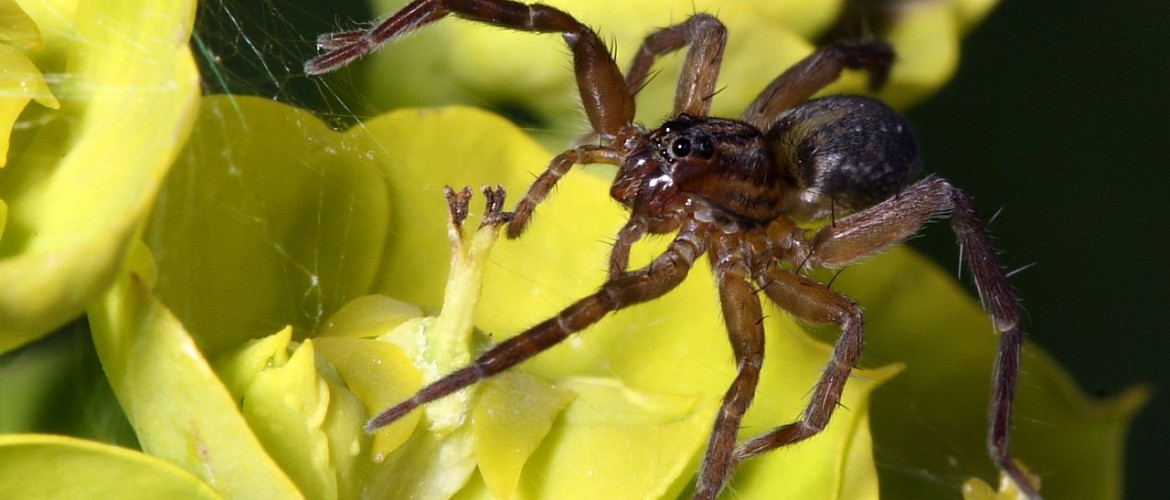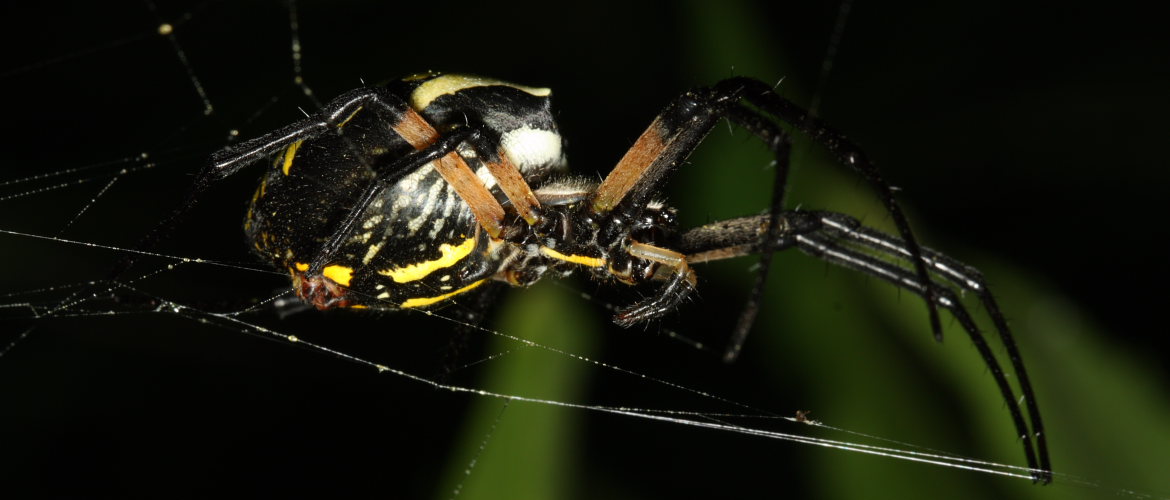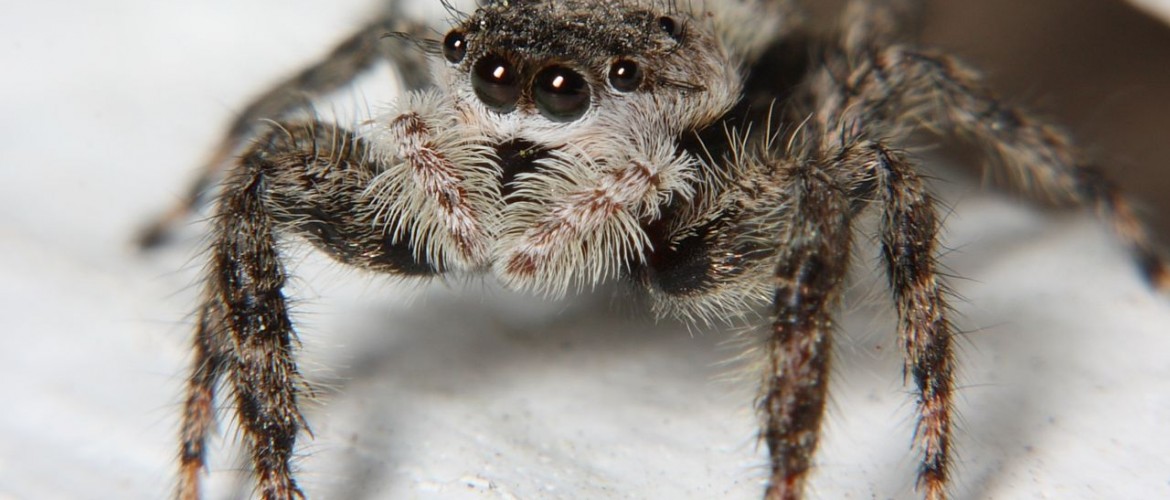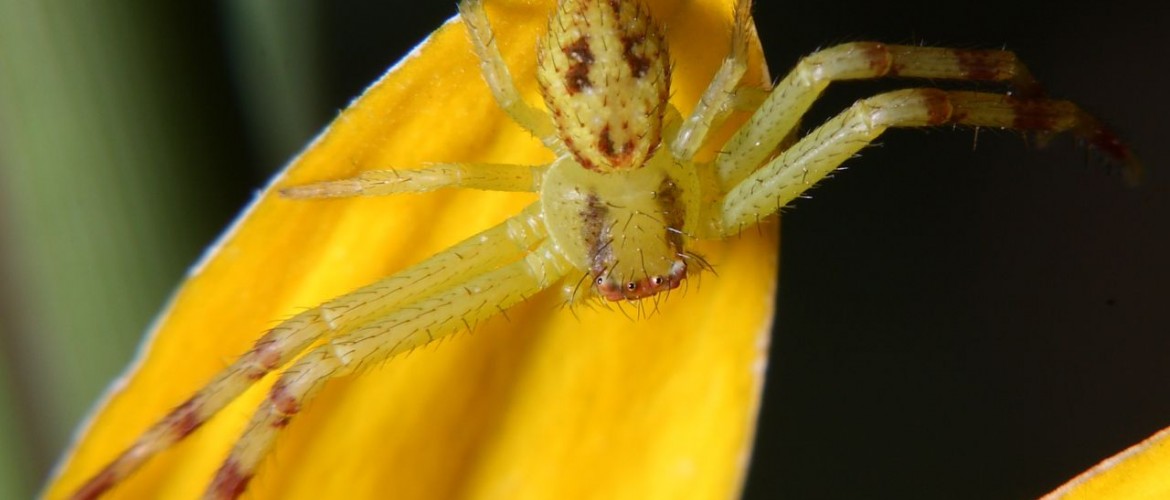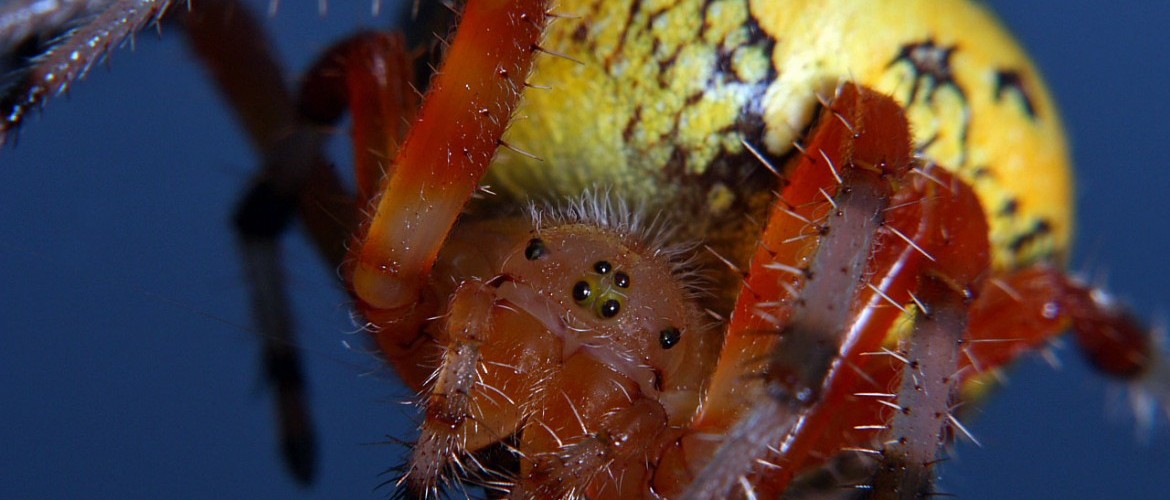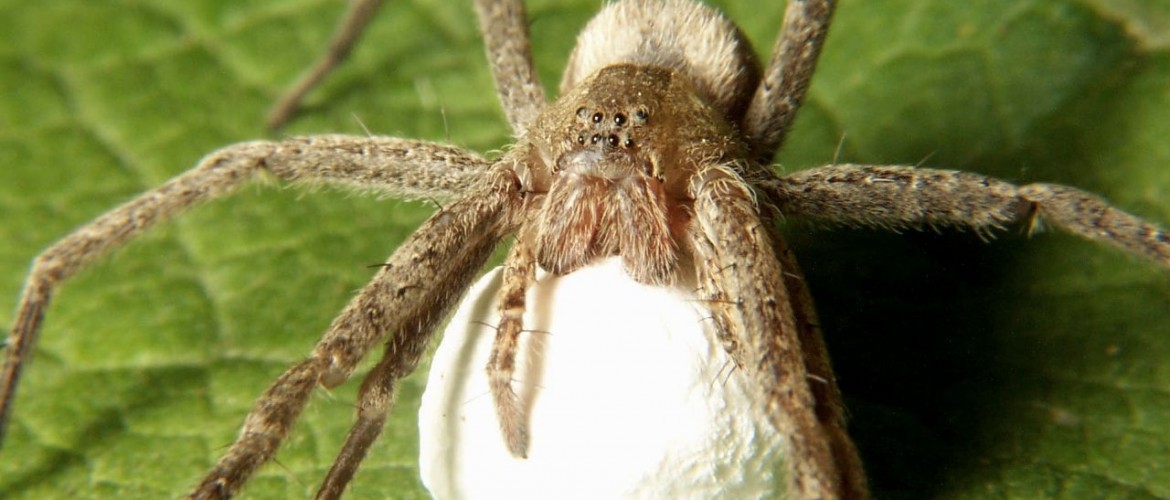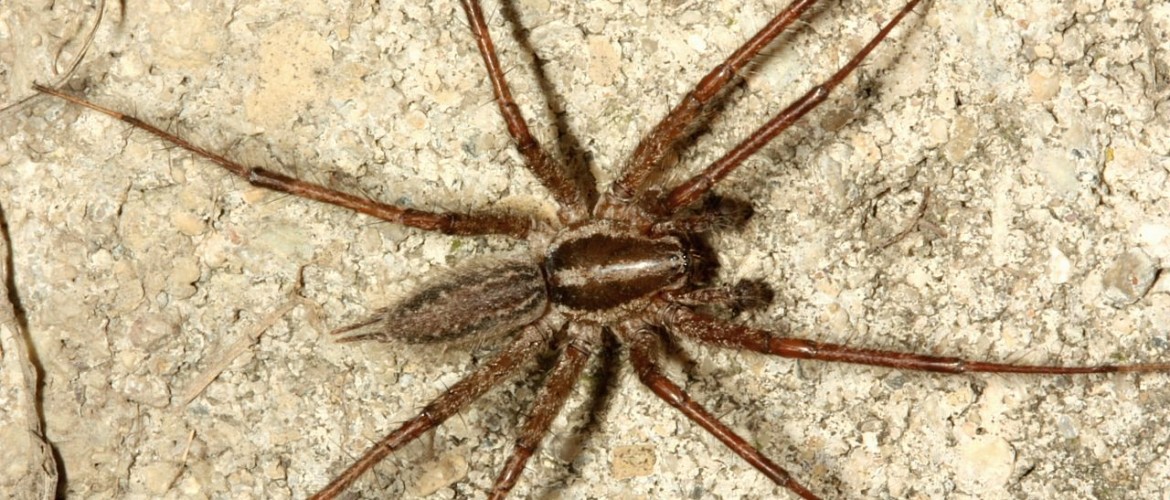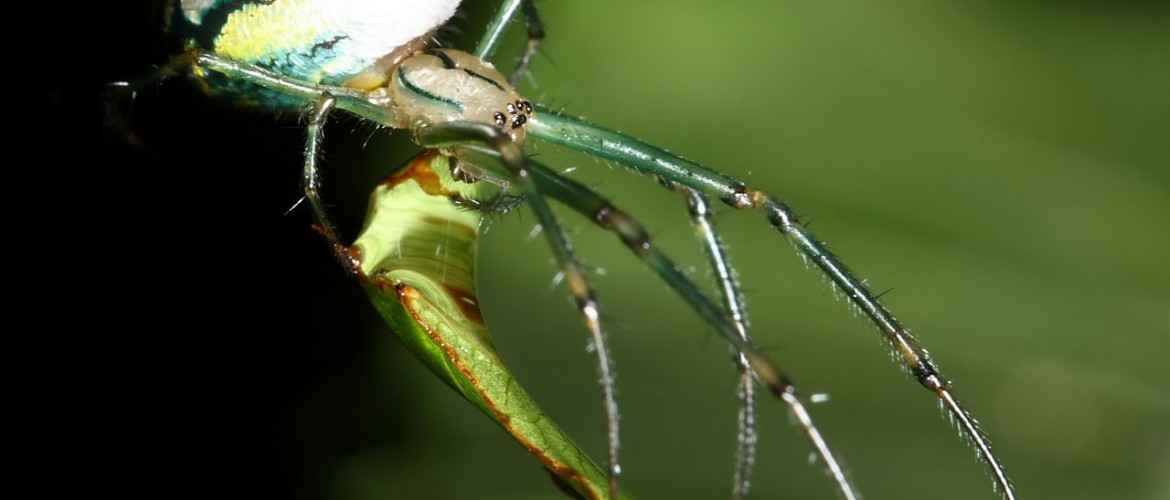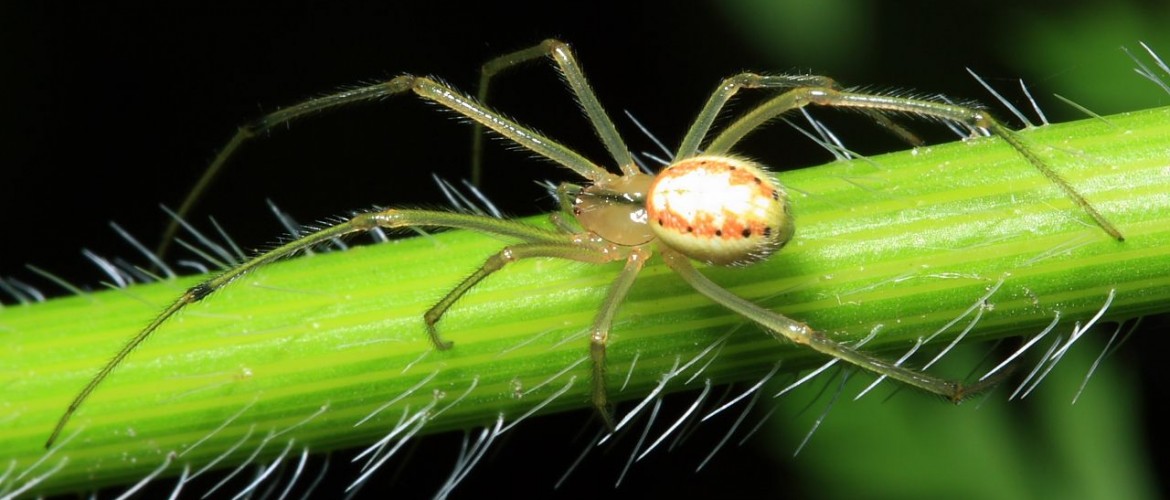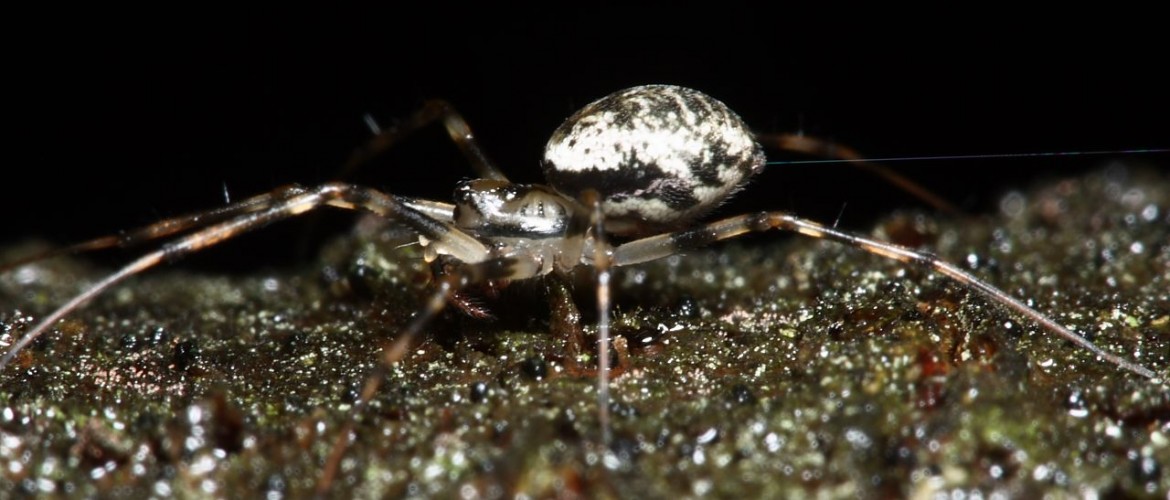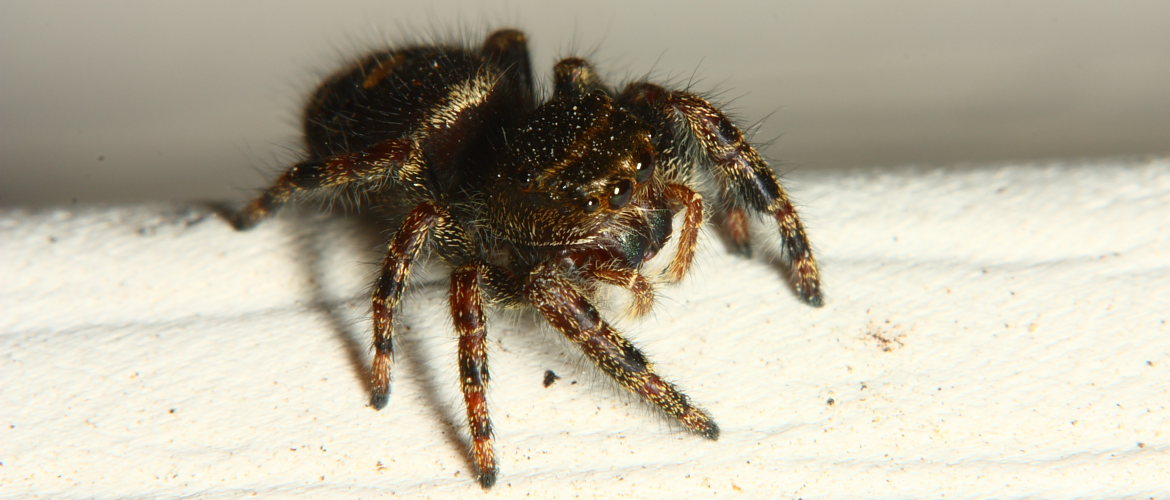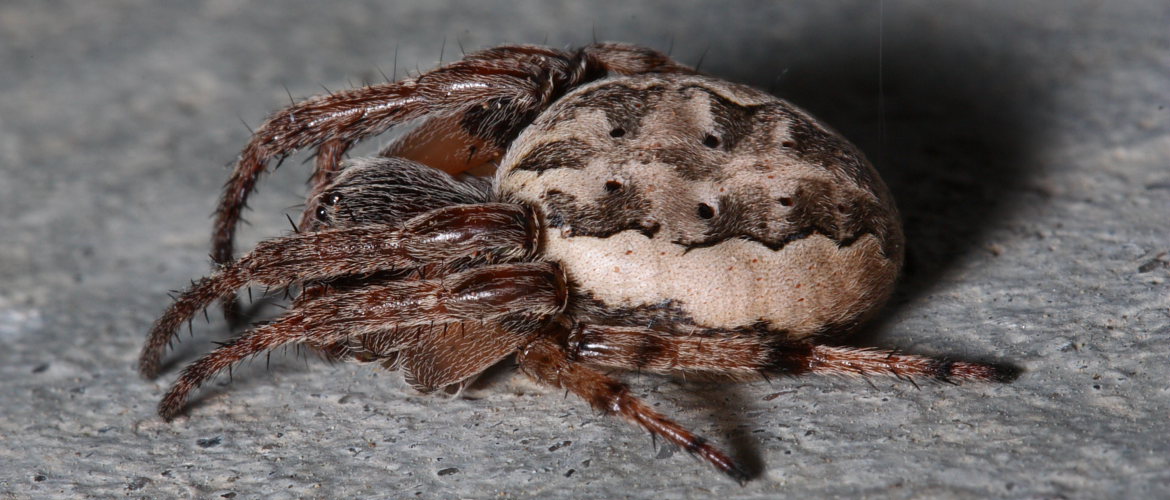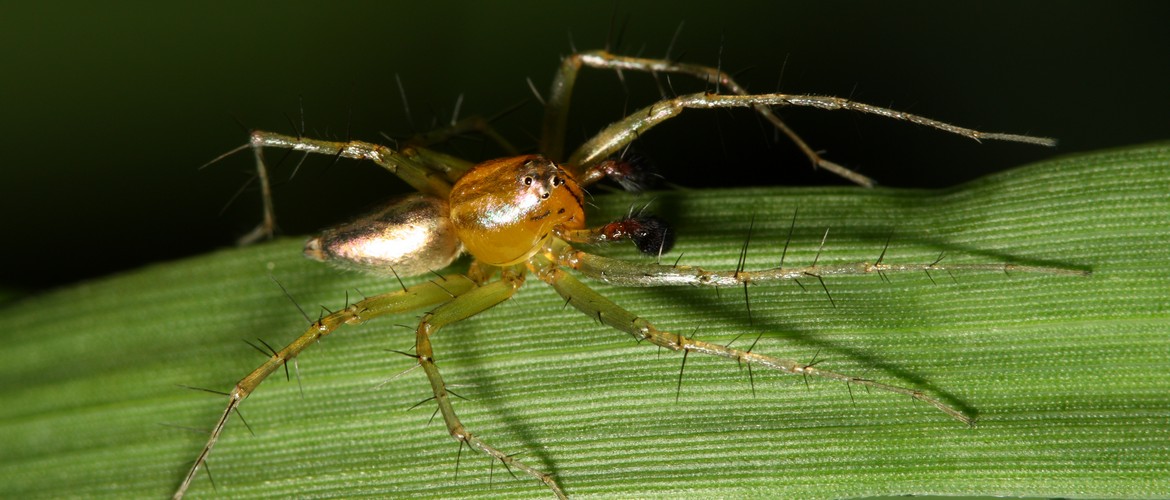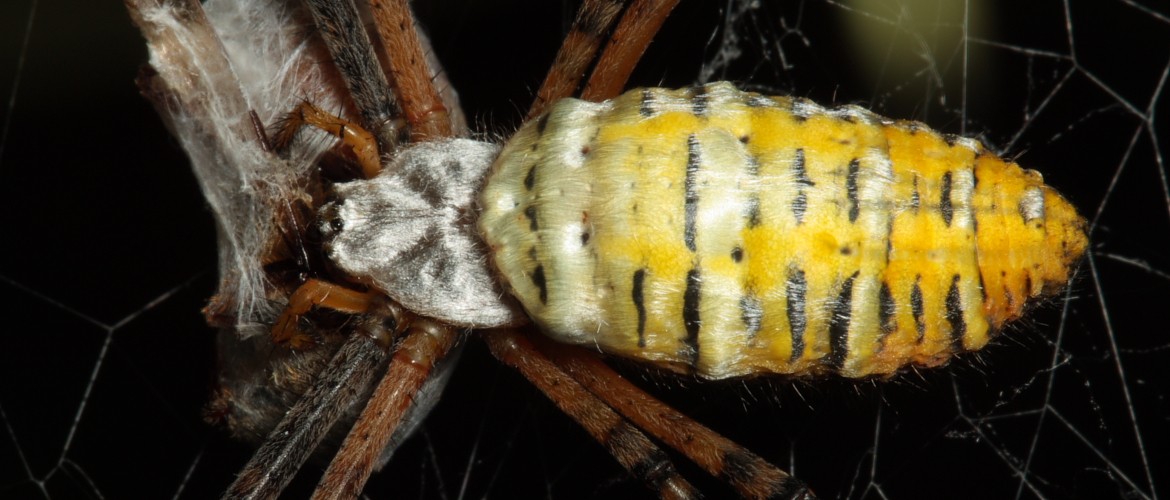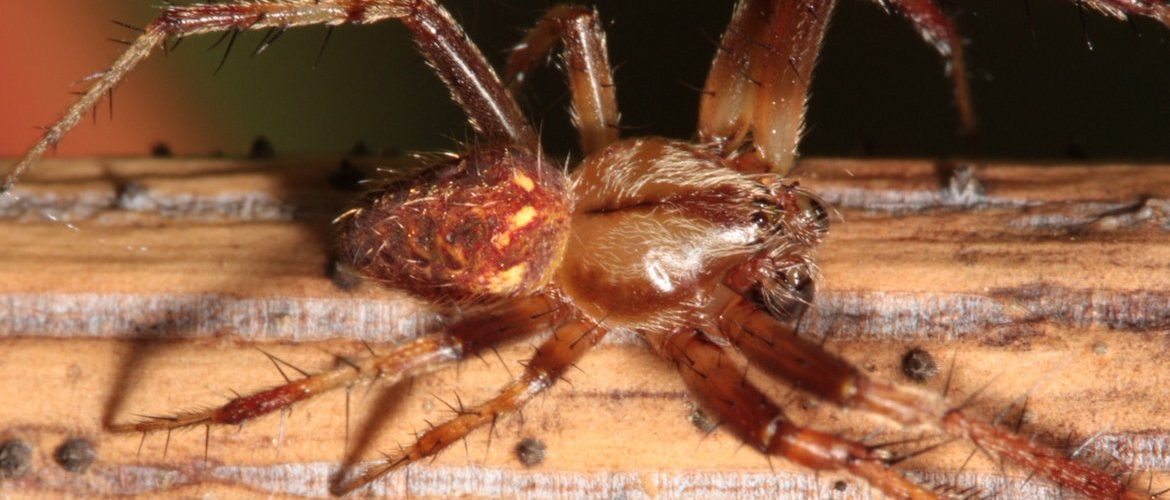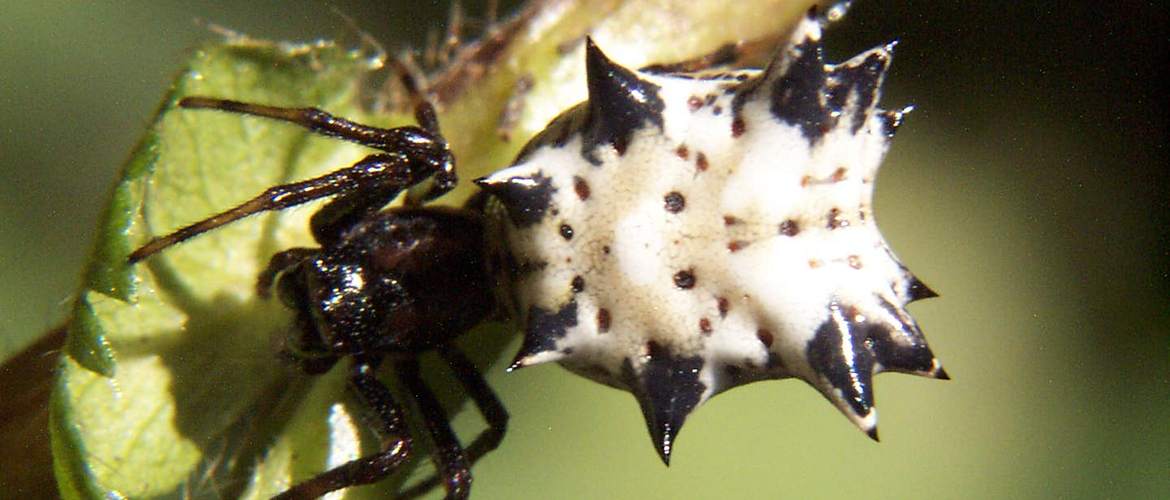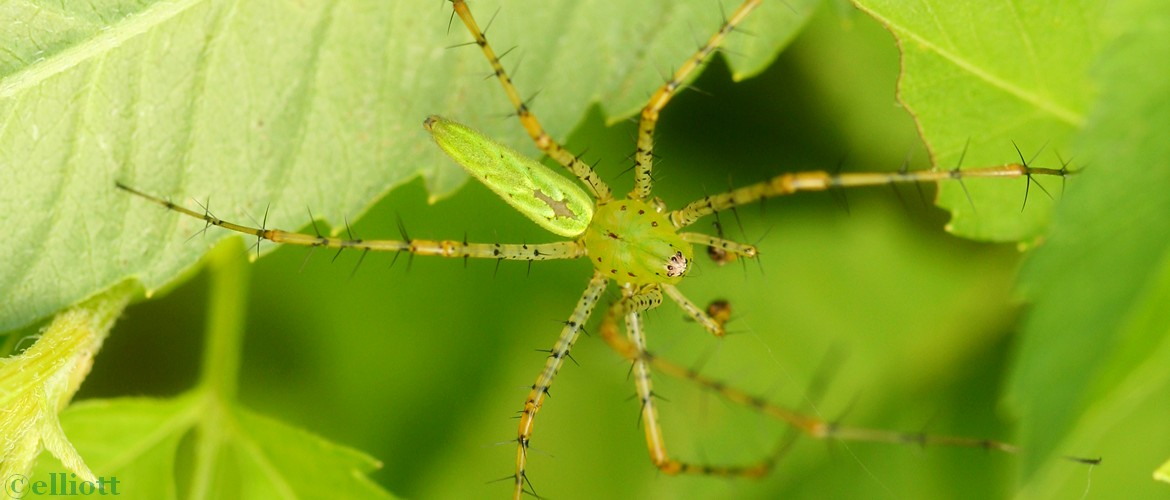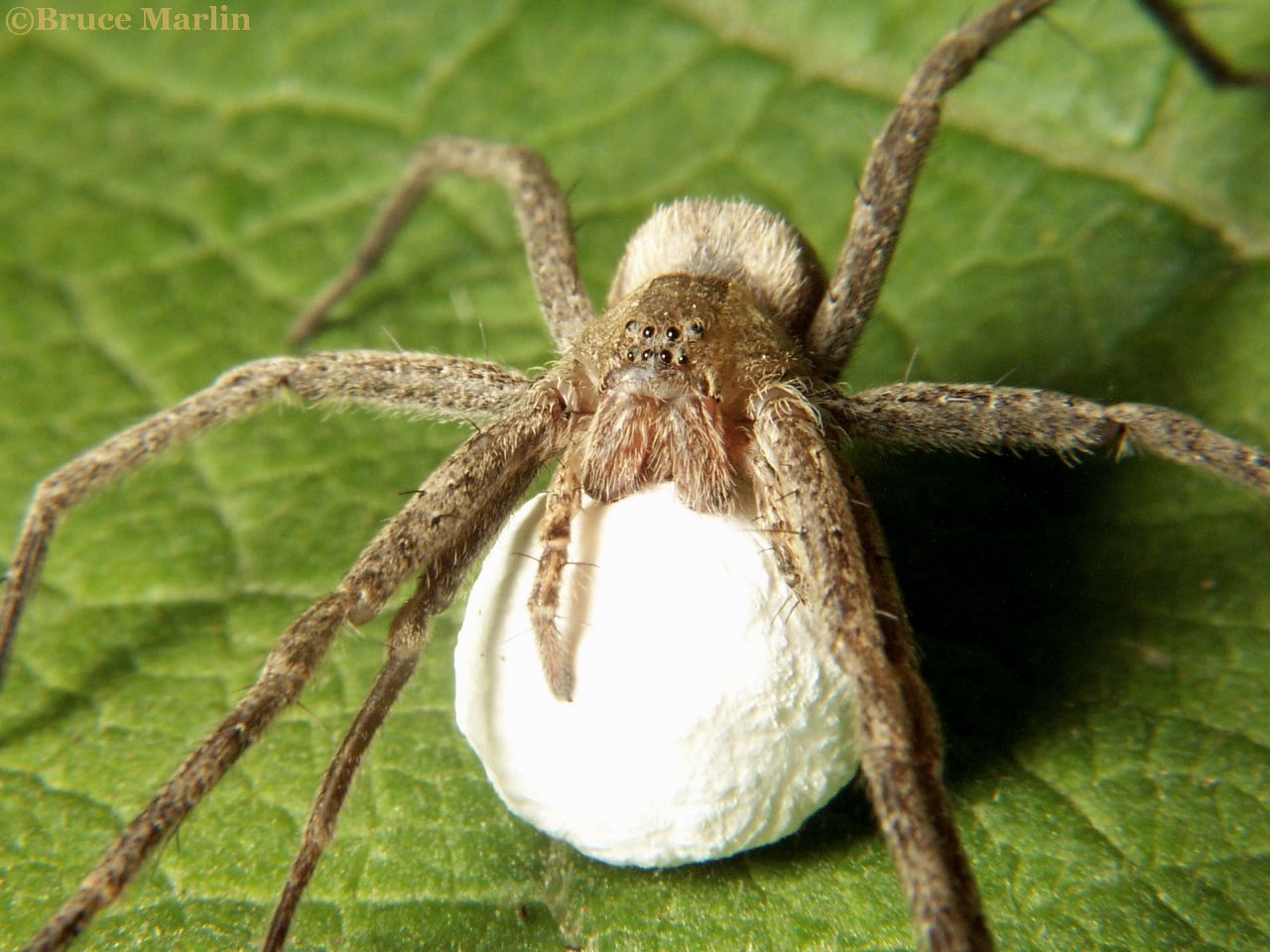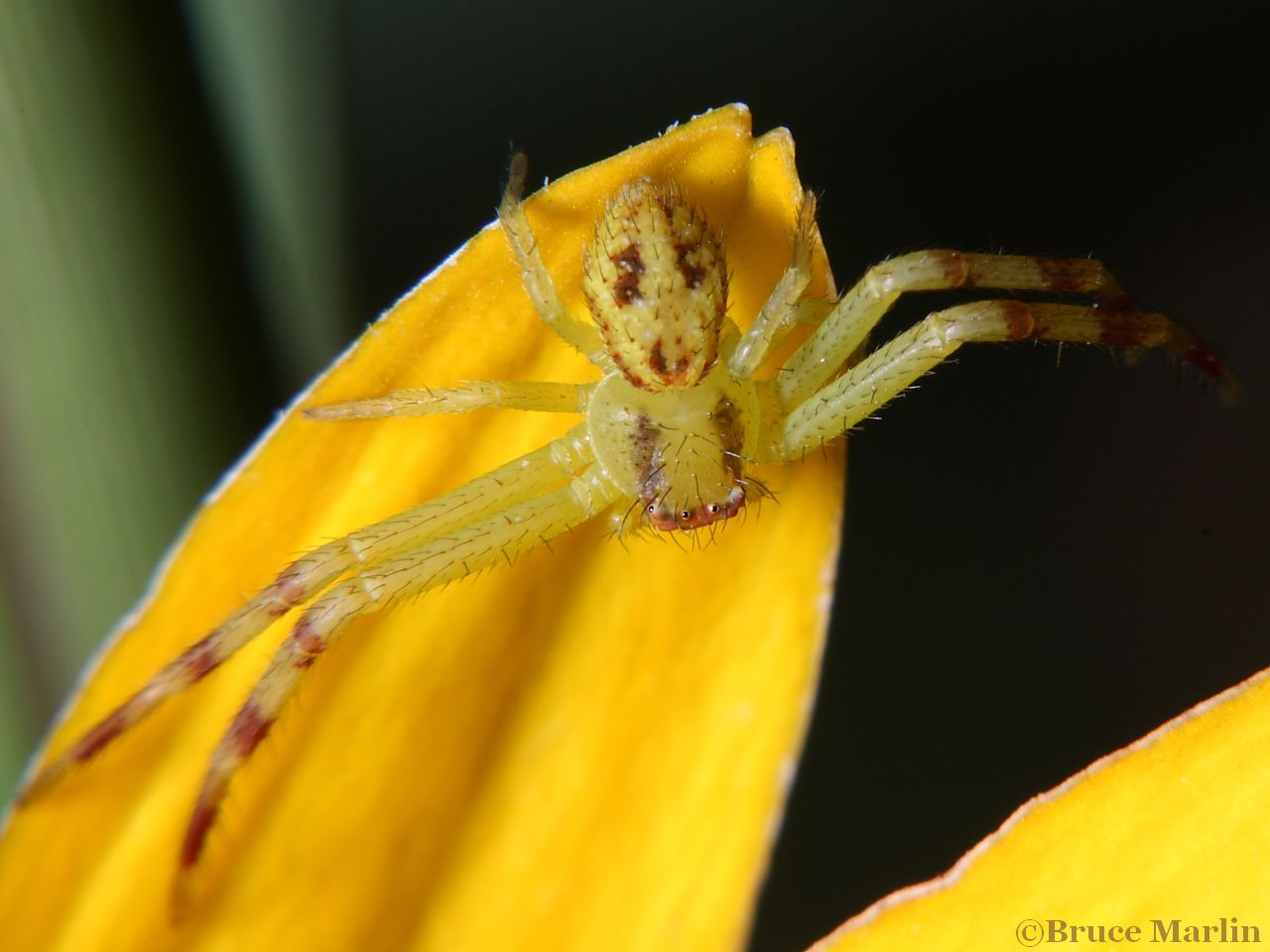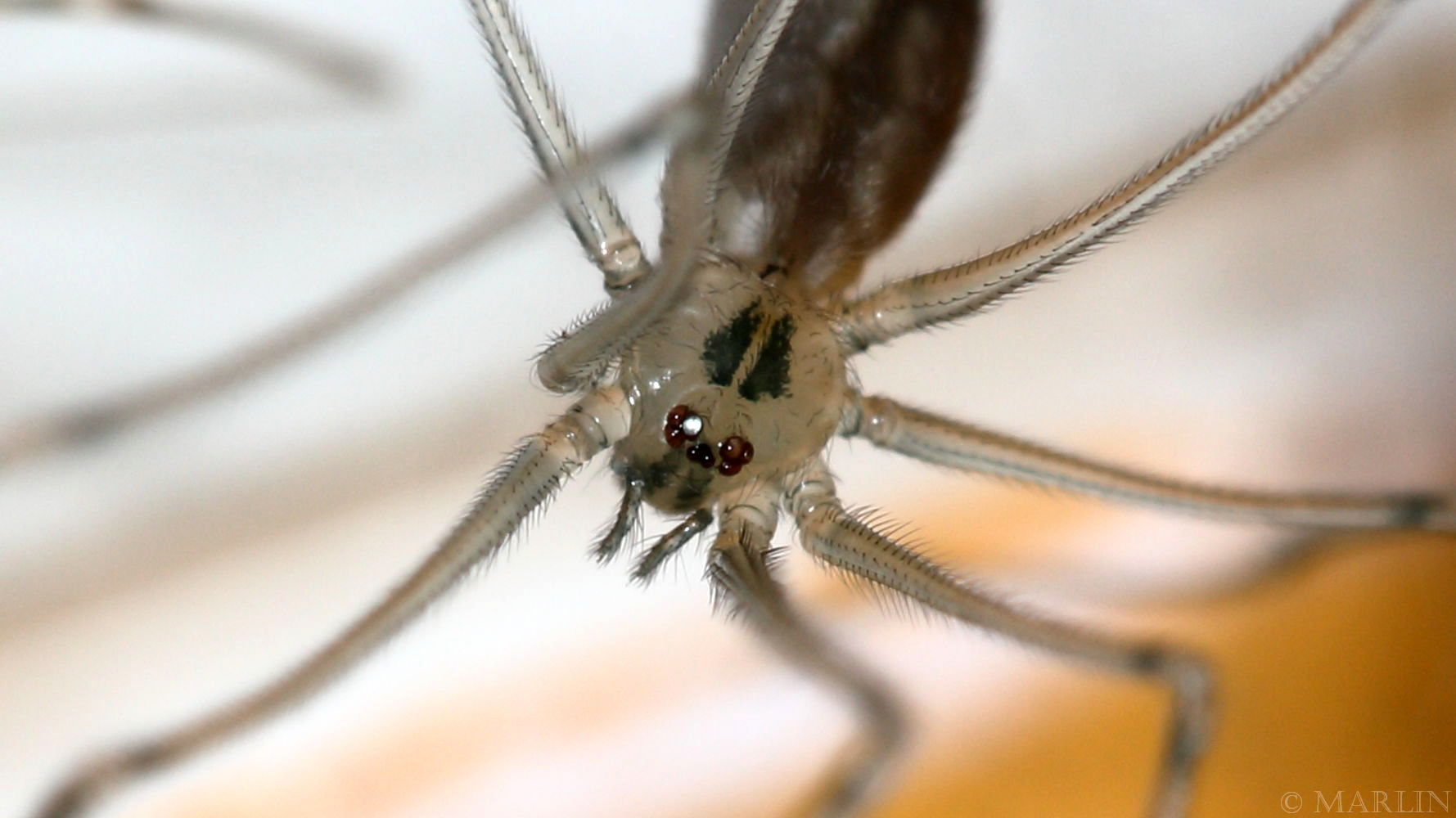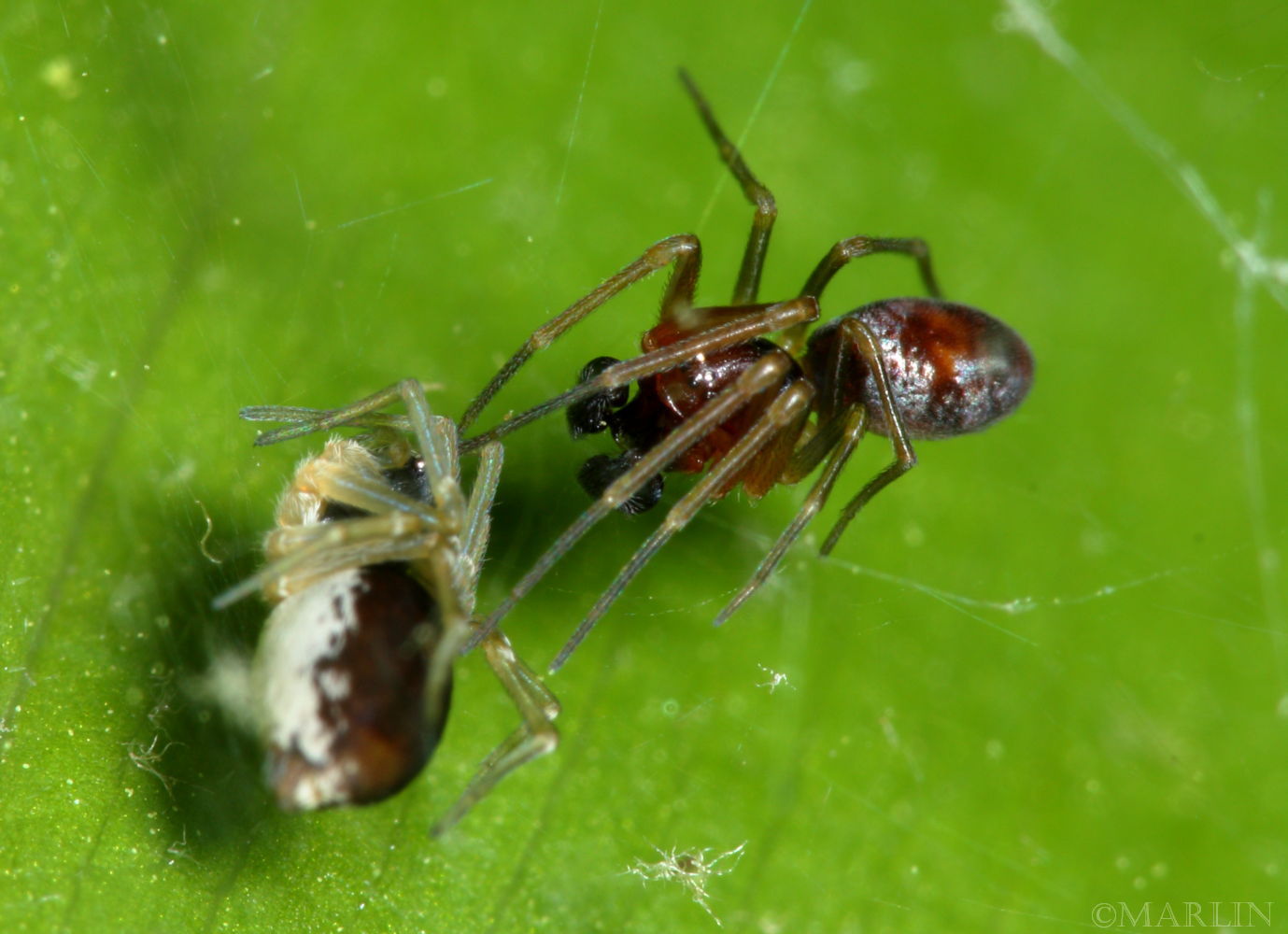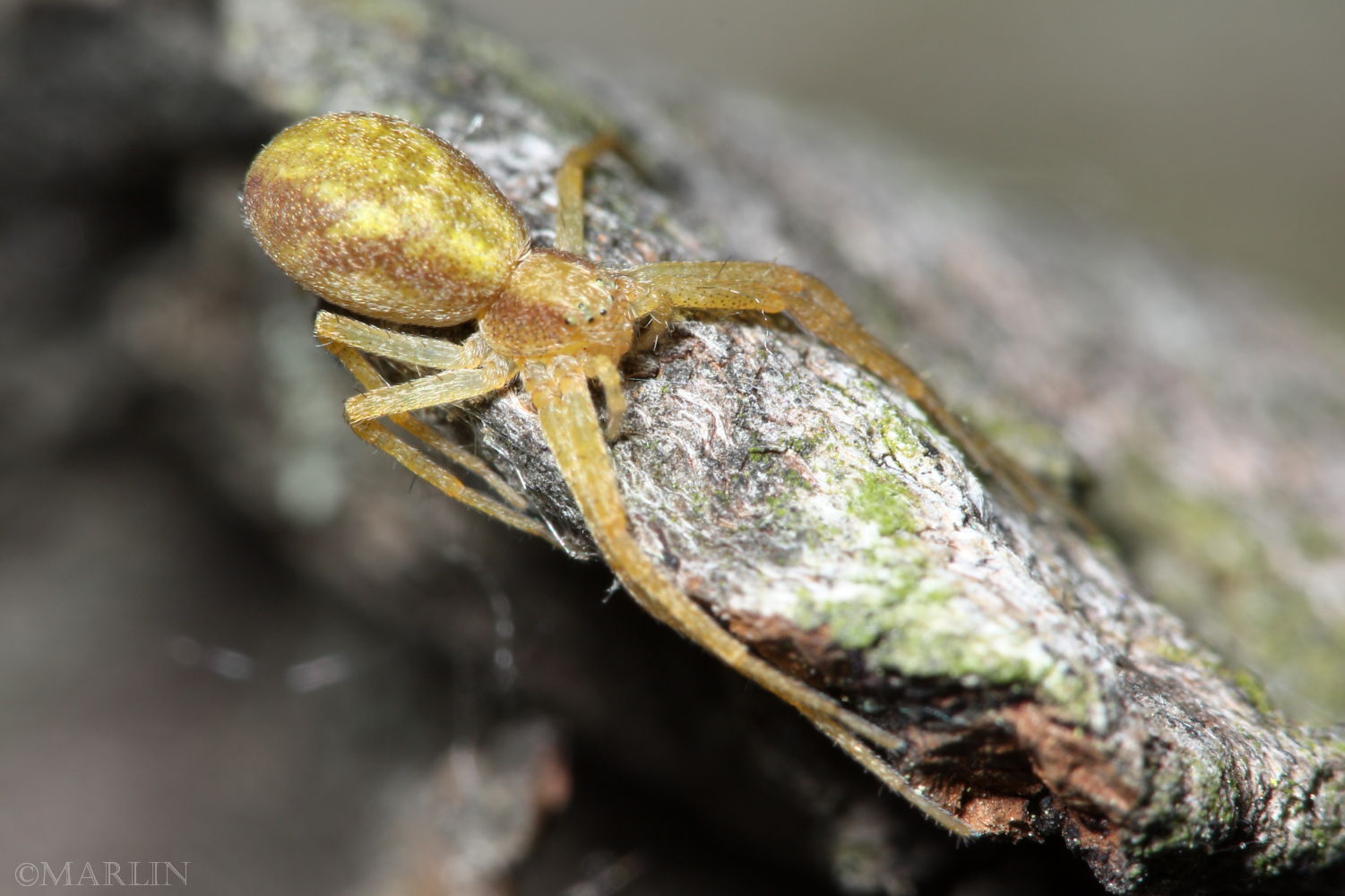Spiders of North America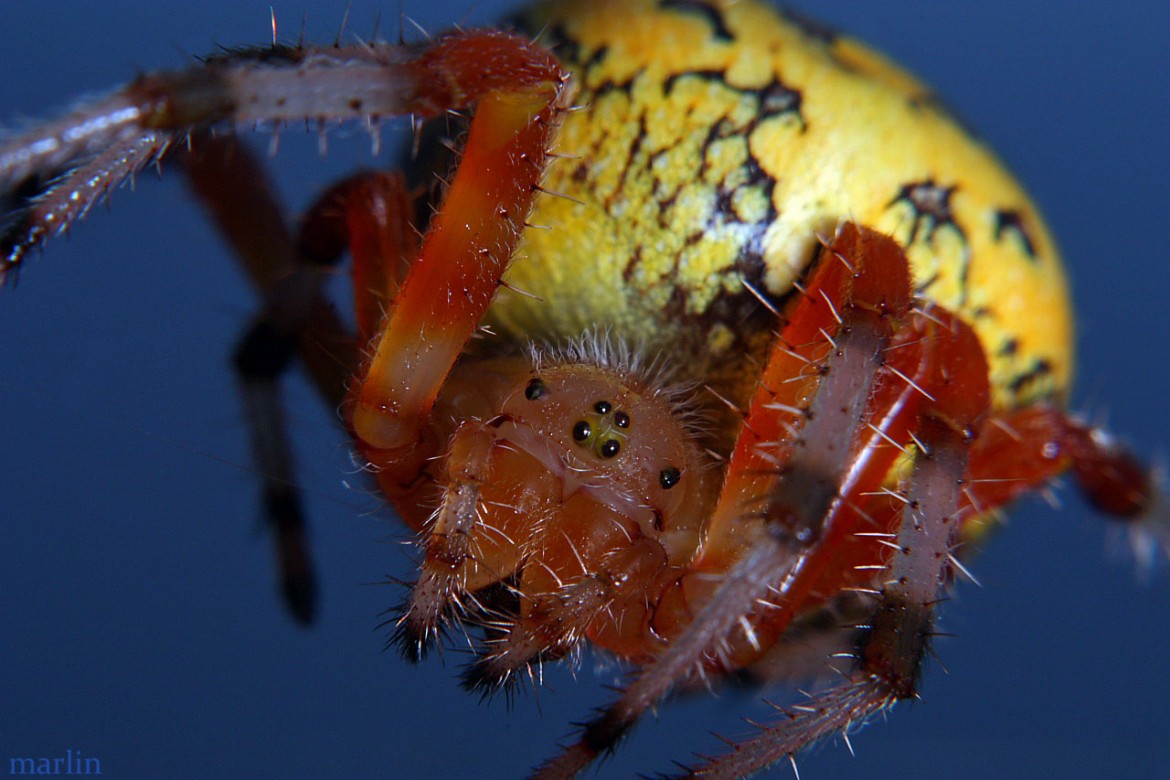
Orb Weavers – Family Araneidae is a huge group of spiders with 3500 species worldwide, 180 of which call North America home. These spiders vary greatly in color, shape and size, measuring between 2 – 30mm (1/16 — 1 1/4″) long.
Orb weavers spin spiraling webs on support lines that radiate outward from the center. They are the result of millions of years of evolution; spider silk is many times lighter and stronger than steel, and the geometrical architecture could not be more economical or efficient.
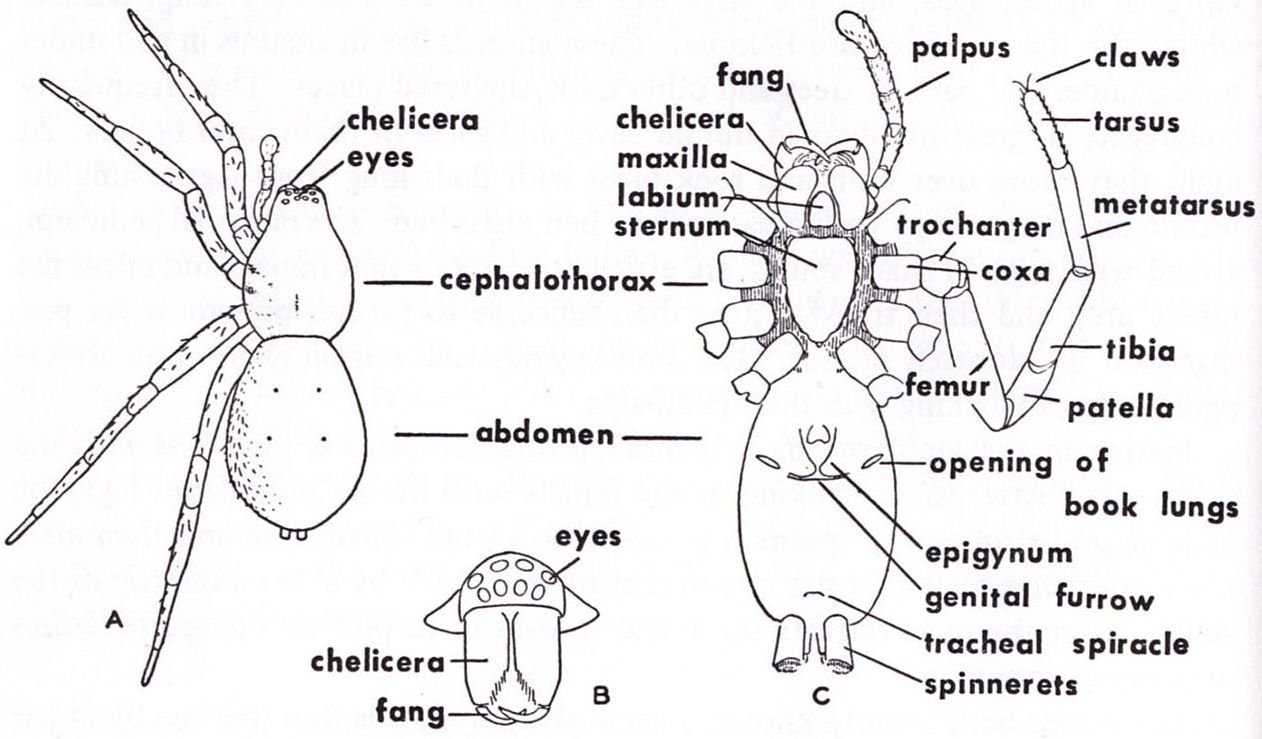 External Spider Anatomy: A. Dorsal (top) view B. Front view of face and chelicerae C. Ventral (bottom) view
External Spider Anatomy: A. Dorsal (top) view B. Front view of face and chelicerae C. Ventral (bottom) view
All spiders are predacious and carnivorous. They subsist on the bodily fluids and chewed up live insects they have paralyzed with their venom.
Their method of feeding is pretty much the same as ours, except their “teeth” and digestive processes are external. The strong chelicerae and the sharp edges of the endites are used to crush and pulverize the prey, all the while bathing the resultant wreckage in copious quantities of digestive fluid from the maxillary glands.
The resultant broth is vacuumed up through the mouth and esophagus by means of powerful muscles that cause expansion of the stomach and gut. It is thought spiders do not ingest solid food, but only predigested liquids. Some hard-bodied insects like beetles are injected with digestive juice through a small hole, and the whole outer cuticle is discarded afterwards.
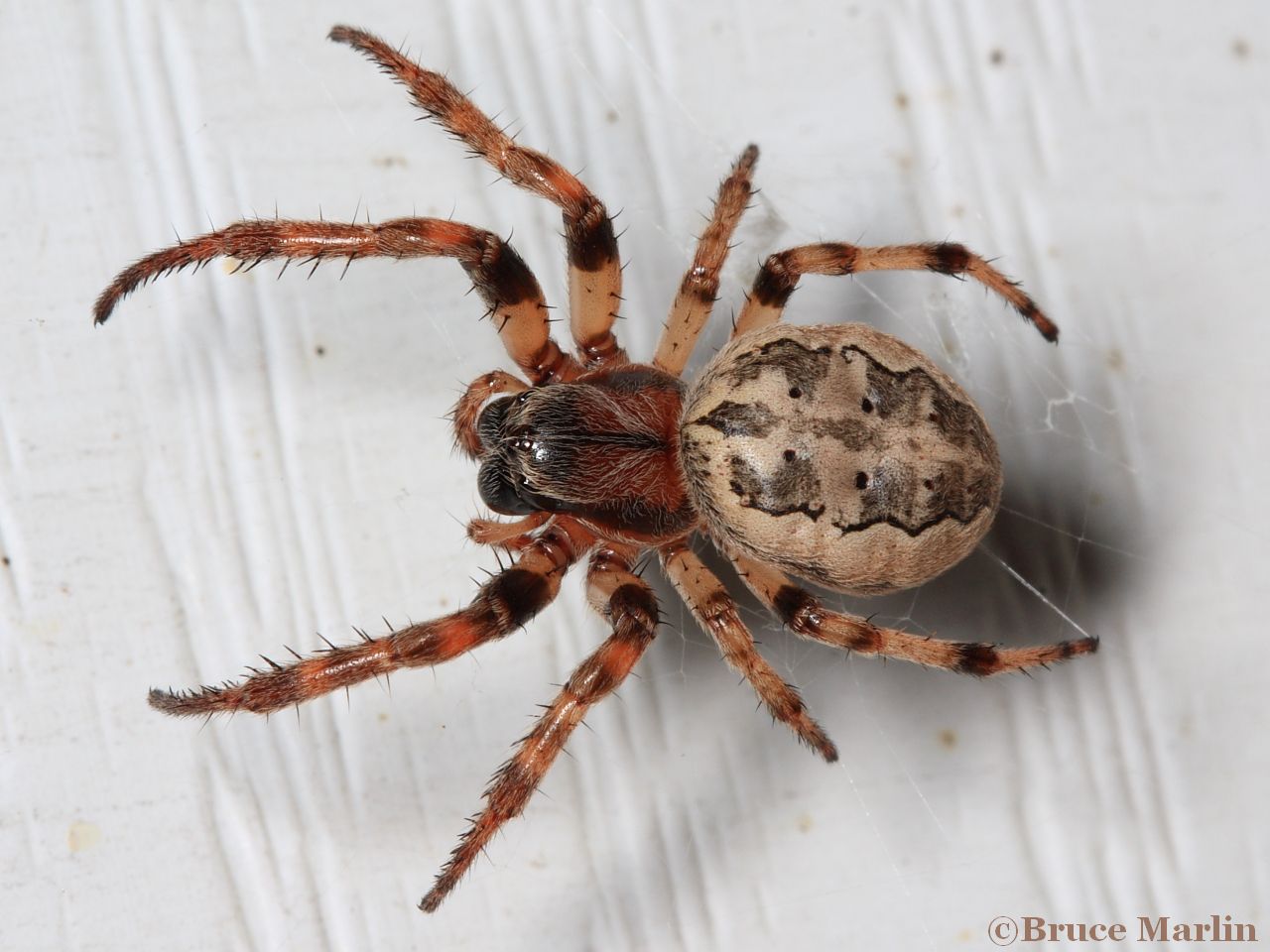 Furrow Spider – Larinioides cornutus mature female = 12mm. Commonly called the furrow or foliate spider, this orb-weaver is very common on human structures, especially under eaves and porches.
Furrow Spider – Larinioides cornutus mature female = 12mm. Commonly called the furrow or foliate spider, this orb-weaver is very common on human structures, especially under eaves and porches.
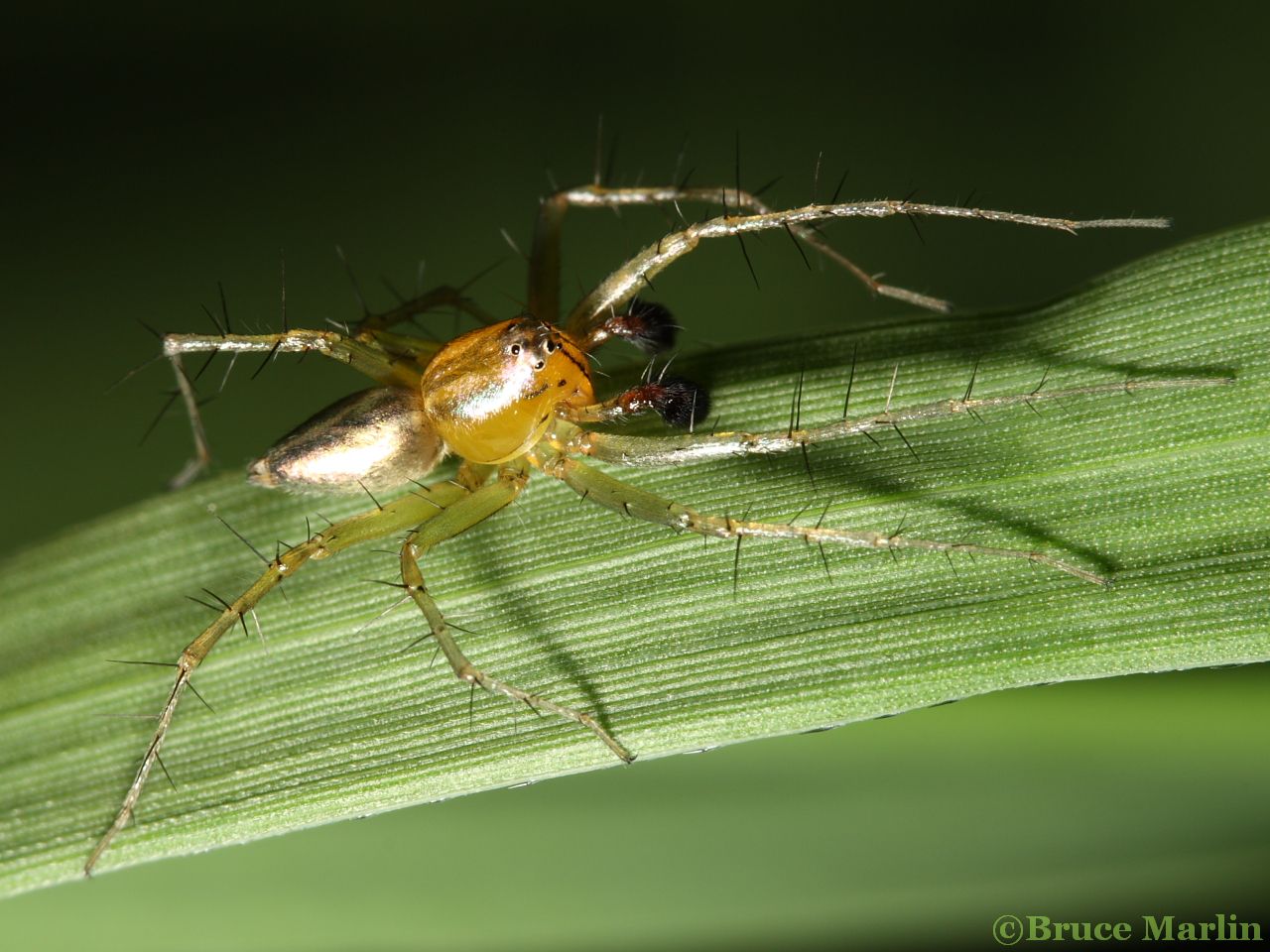 Lynx Spiders – Family Oxyopidae are diurnal, that is, they hunt during daylight hours. Their hunts are conducted much like those of their namesake; they roam the foliage looking for prey.
Lynx Spiders – Family Oxyopidae are diurnal, that is, they hunt during daylight hours. Their hunts are conducted much like those of their namesake; they roam the foliage looking for prey.
Their eyesight is not as keen as jumping spiders, and they more often use the “wait and pounce” hunting tactic most often associated with the (equally well) camouflaged crab spiders.
 Family Salticidae – Jumping Spiders are active hunters that capture prey by stalking and pouncing, exactly like larger predators. Salticids range from 3-15 mm (1/8 — 5/8″) long. They have the most acute eyesight of all spiders, and can jump more than fifty times their own body length.
Family Salticidae – Jumping Spiders are active hunters that capture prey by stalking and pouncing, exactly like larger predators. Salticids range from 3-15 mm (1/8 — 5/8″) long. They have the most acute eyesight of all spiders, and can jump more than fifty times their own body length.
Jumping spiders can and do leap onto flying insects passing by; they use their dragline silk to winch themselves back to their previous promontory.
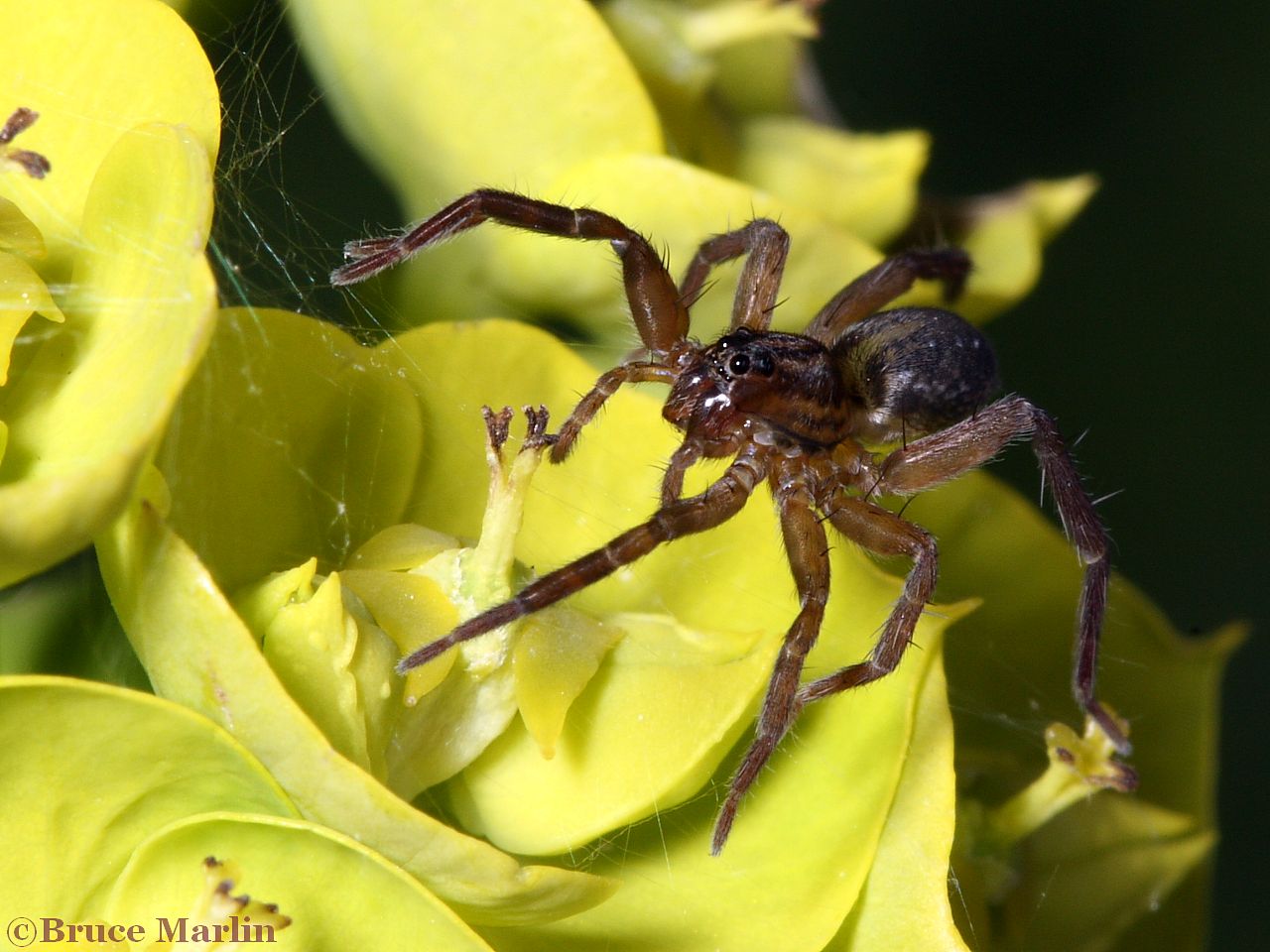 This small (5mm) pirate wolf spider constructed a sort of scaffolding web encasing several flowers, upon which she can rapidly attack any prey that happen to blunder into range.
This small (5mm) pirate wolf spider constructed a sort of scaffolding web encasing several flowers, upon which she can rapidly attack any prey that happen to blunder into range.
Wolf Spiders – Family Lycosidae are active hunters. The female spins a large spherical egg sac, attaches it to her spinnerets and drags it around until the eggs hatch. The hatchlings then climb onto her back and stay there until they are able to fend for themselves.
Nursery Web and Fishing Spiders do not build webs to catch prey, but use silk to construct a special nest or nursery web. The female carries a spherical egg sac around until the eggs are ready to hatch, then constructs a web and places the egg sac inside. She then stands guard nearby until the spiderlings have all grown and dispersed.
Some of the largest spiders in this family, the fishing spiders, run over the surface of ponds and streams, and sometimes even go under water. They may capture tadpoles and small fishes near the surface, but mostly prey on insects.
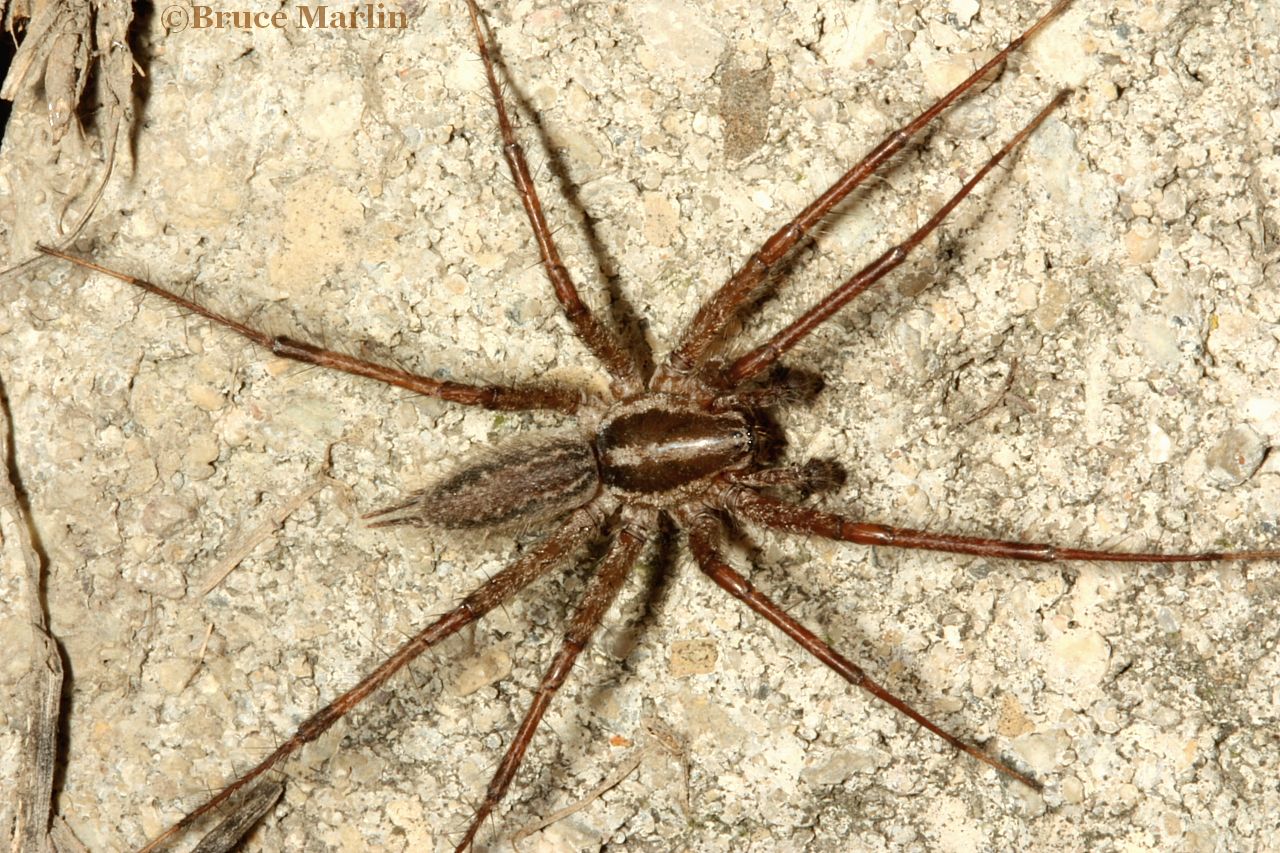 Funnel web weavers (Family Agelenidae) are often found in grassy fields, low shrubbery, or living among leaf litter in forests. They spin sheet webs of non-sticky silk with a characteristic funnel extending off to one side. The so-called Hobo spider (Tegenaria agrestis) is a member of this family.
Funnel web weavers (Family Agelenidae) are often found in grassy fields, low shrubbery, or living among leaf litter in forests. They spin sheet webs of non-sticky silk with a characteristic funnel extending off to one side. The so-called Hobo spider (Tegenaria agrestis) is a member of this family.
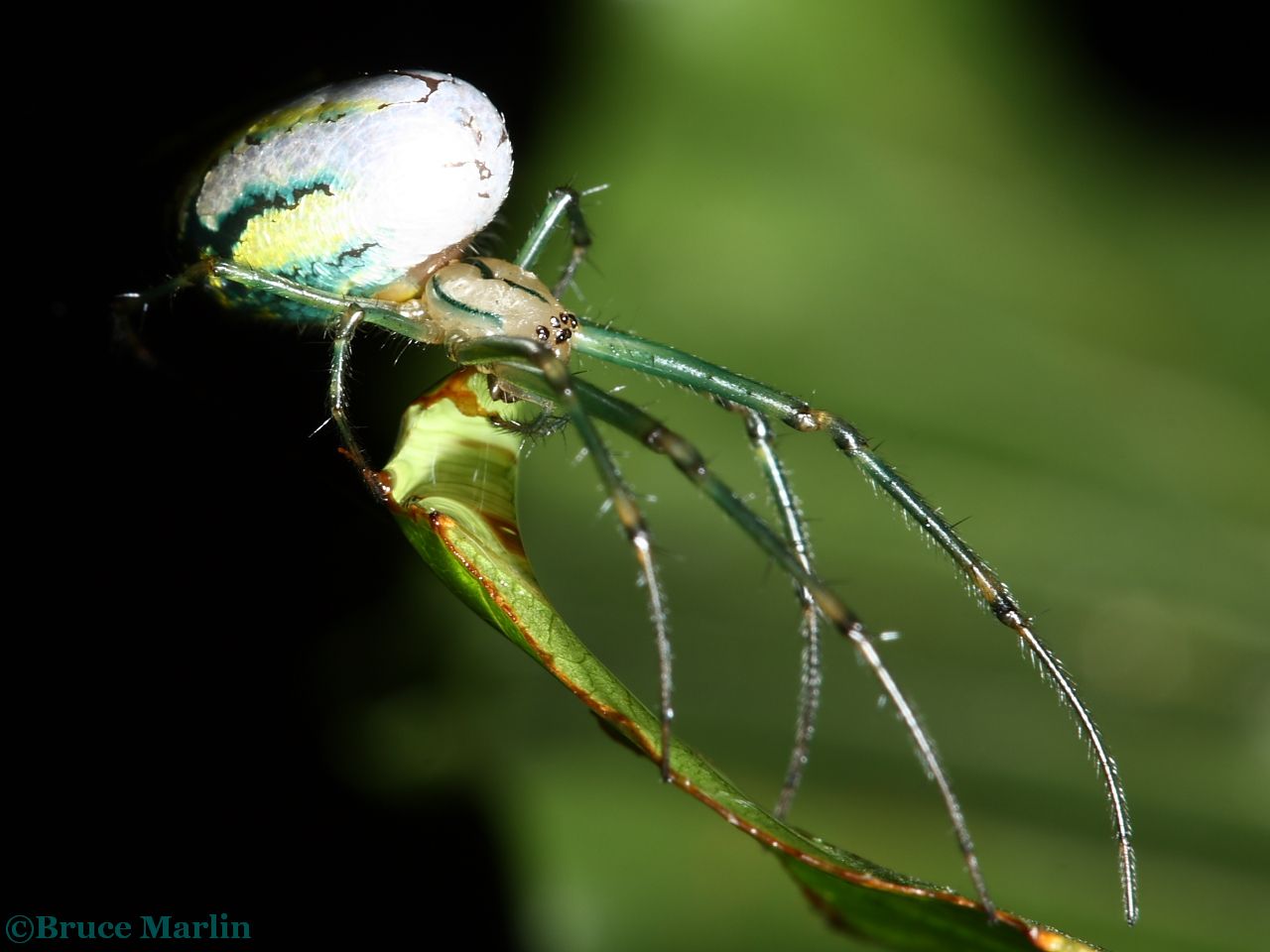 Family Tetragnathidae – Long-Jawed Orb Weavers are usually easy to identify by their eponymous huge, powerful chelicerae (jaws) and long, slender abdomen. The Venusta Orchard spider, (above) is a very common woodland arachnid, is a member of this family.
Family Tetragnathidae – Long-Jawed Orb Weavers are usually easy to identify by their eponymous huge, powerful chelicerae (jaws) and long, slender abdomen. The Venusta Orchard spider, (above) is a very common woodland arachnid, is a member of this family.
Crab spiders (Family Thomisidae) hold their legs outstretched to the sides, in the manner of their crustacean namesake. They have short, broad bodies and 8 small eyes sometimes located on raised bumps.
Masters of camouflage, crab spiders do not build any sort of web – they prowl the ground and climb flowers and plants in search of prey.
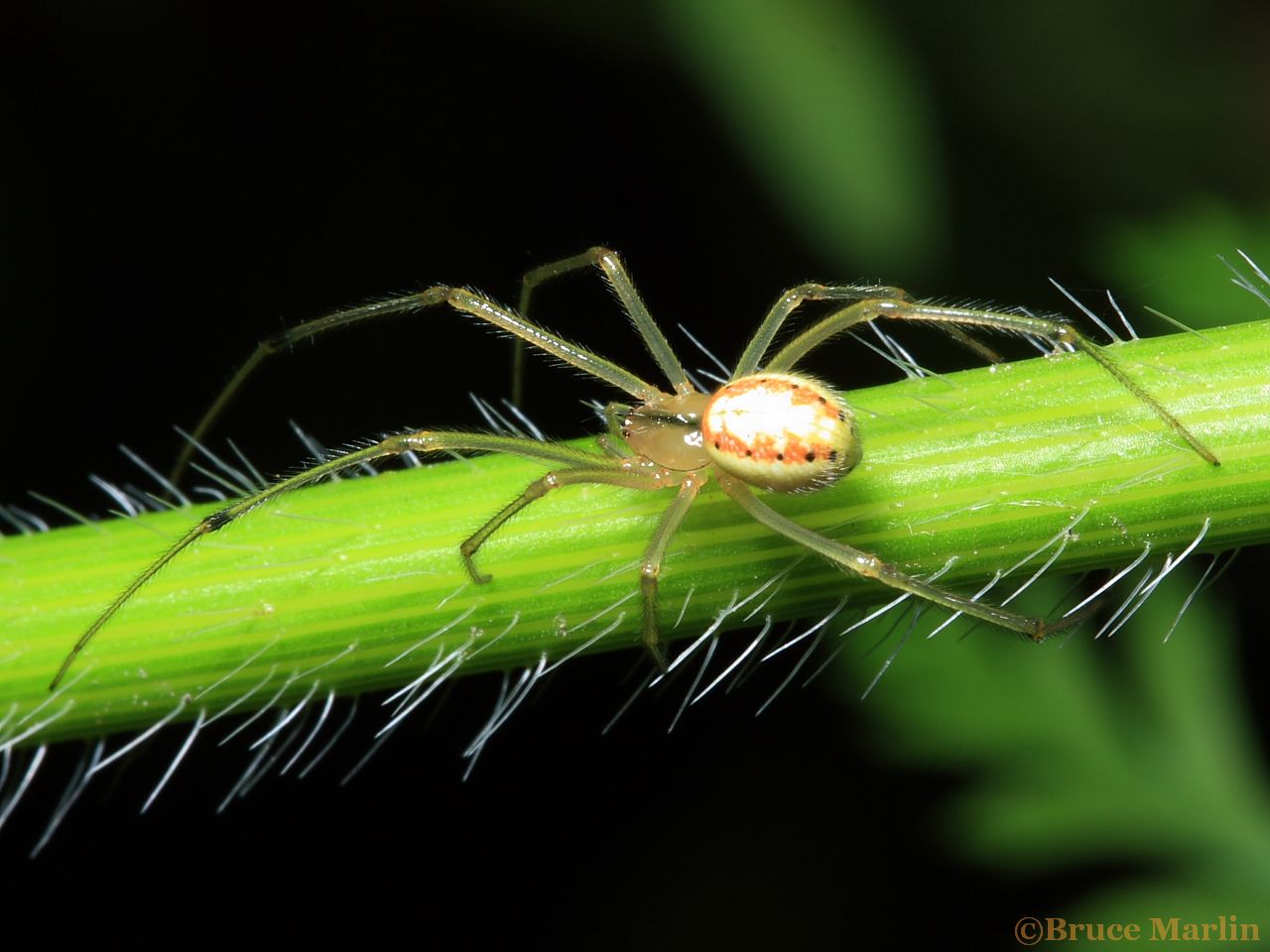 Cobweb spiders (Family Theridiidae) are also called comb-footed spiders, after the inconspicuous comb-like bristles on the hind tarsi of many species. These spiders spin irregular webs (cobwebs) and use their combs to fling silk over any prey that gets caught in the web. There are more than 200 North American species in this family – which includes the black widow spider.
Cobweb spiders (Family Theridiidae) are also called comb-footed spiders, after the inconspicuous comb-like bristles on the hind tarsi of many species. These spiders spin irregular webs (cobwebs) and use their combs to fling silk over any prey that gets caught in the web. There are more than 200 North American species in this family – which includes the black widow spider. Sheetweb and dwarf spiders, family Linyphiidae is the second largest after Salticidae. Comprised of 4,300 described species in 578 genera, this family is poorly known because of their small size.
Sheetweb and dwarf spiders, family Linyphiidae is the second largest after Salticidae. Comprised of 4,300 described species in 578 genera, this family is poorly known because of their small size.
Sheetweb spiderwebs can be flat, convex or concave, or can simply hug the substrate contours, as this spider demonstrates.
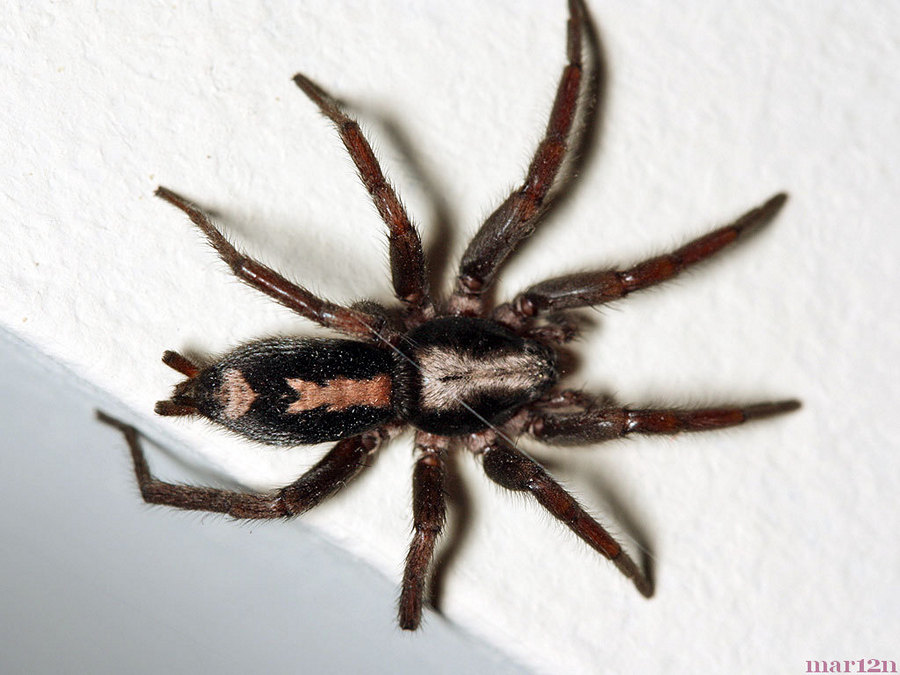
Eastern Parson Spider – Family Gnaphosidae (Ground Spiders). Completely harmless, but big and black and hairy, this common indoor spider can startle the best of us.
Cellar / Vibrating Spiders – Family Pholcidae
Often live in dark, undisturbed places like basements and attics. They are small-bodied spiders with very long, thin legs. Many are capable of “vibrating” their way to invisibility; you can see a video of this process here.
Mesh-Web Weavers – Family Dictynidae
Tiny spiders in this family are all under 5mm long, most are in the 2-3mm range. There are approximately 290 species in 20 genera.
Running Crab Spiders – Family Philodromidae
These are very common spiders that frequently live in human dwellings – they are likely culprits when you find cobwebs in the corners of your ceilings.
Other arachnids of note:
Lone Star Tick According to the Center for Disease Control, the lone star tick is a concern, but not for Lyme disease.
American Dog Tick The American dog tick is the largest of the eastern wood ticks. Ticks are parasites, and American dog ticks are known as “three host” ticks because they use three different hosts during their development.
Blacklegged Tick or Deer Tick According to the Centers for Disease Control, Lyme disease is now the most common vector-borne infection in humans in the United States.
Red Velvet Mite Velvet mites are critically important to soil replenishment and sanitation, preying on tiny insects that feed on bacteria and fungi that live in the soil.

